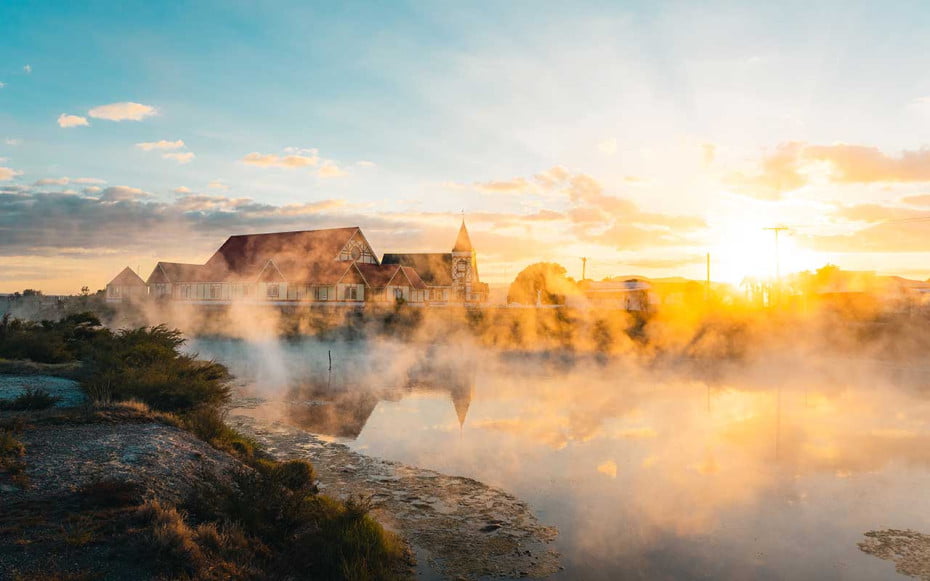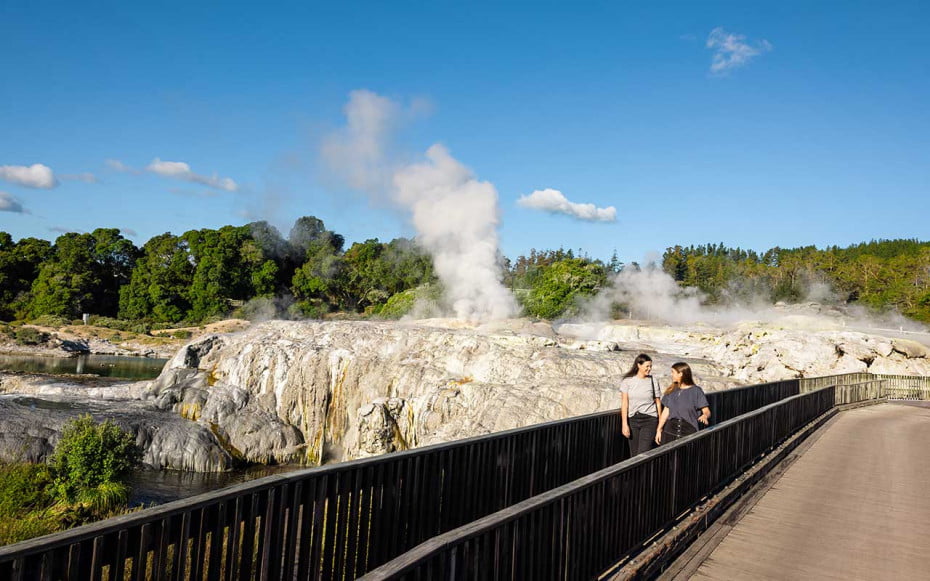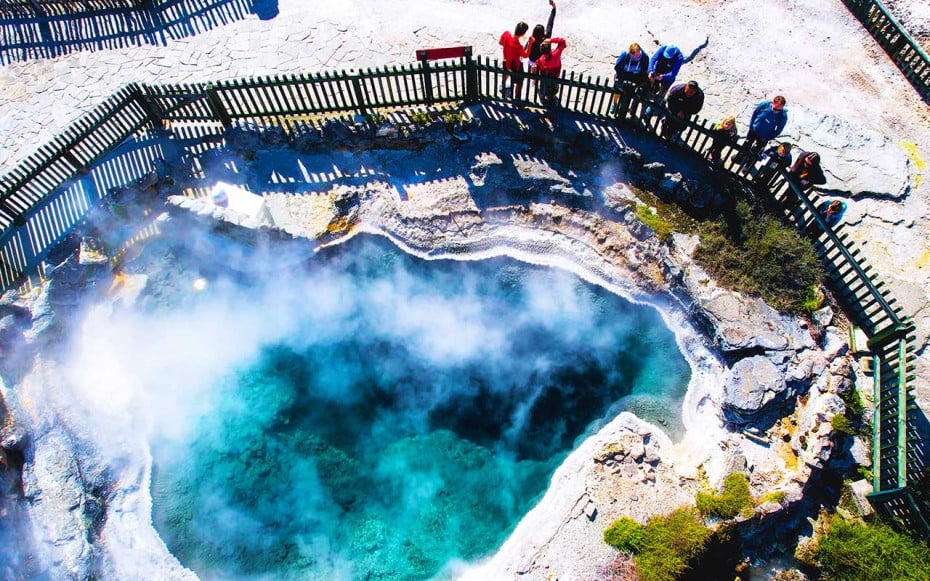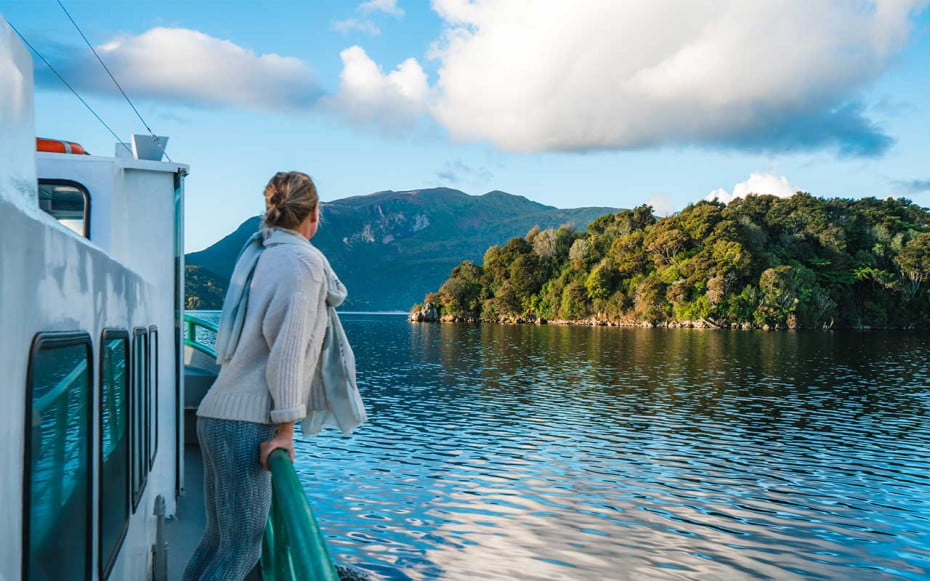Rotorua history & Māori culture
Rotorua is entertaining in any weather, and at any time of the year. It's is well known for its fascinating historical stories and geothermal phenomena. This area of New Zealand promises to keep you captivated. From bubbling mud pools, shooting geysers and natural hot springs, as well as showcasing of fascinating Māori culture.

Visit Ohinemutu, the original Māori settlement
Before Europeans settled in Rotorua, the lakeside village of Ohinemutu was the main centre. Today the area still has a sense of importance, and it's free to see.
Ohinemutu's most admired building is the beautiful Saint Faith's church. Here, Māori carvings and woven panels mix with European religious traditions to create a unique building. The most photographed feature is the decorative window. It's etched with the image of Jesus Christ wearing a Māori cloak.
Explore Te Puia
Te Puia is a captivating place to experience geothermal attractions and Māori Culture.
Experience New Zealand's geothermal wonderland. Te Ra, the daytime experience, includes exploring the 60-hectare Te Whakarewarewa geothermal valley. Walk alongside a beautiful landscape of uncovered natural bush and over 500 bubbling geothermal features. The highlight is the majestic Pōhutu Geyser, the largest active geyser in the Southern Hemisphere. As part of the day pass, explore the kiwi noctarium and traditional Māori carvings.
New Zealand Māori Arts and Crafts Institute
The entry to Te Puia includes access to the New Zealand Māori Arts & Crafts Institute (NZMACI). Since 1926, this important centre has taught young artisans traditional carving, weaving and tattoo (moko) skills. It's much more than a tourist attraction, it's a thriving school that's keeping the Māori art traditions alive.

Discover free geothermal attractions at Kuirau Park
Many of Rotorua's geothermal features are free to see, like those at Kuirau Park. This central public park has free geothermal foot baths and boardwalks alongside steaming geothermal attractions. New features erupt from time to time, so the park's fences keep moving to keep visitors safe.
Another area for free geothermal sightseeing is the walking track at the edge of Sulphur Bay. Or why not visit the active Rachel Spring near Rotorua Museum.
Wander the geothermal wonders of Whakarewarewa Village
Te Puia and Whakarewarewa Village share access to the Whakarewarewa geothermal area. However, admission through Whakarewarewa Village offers something different. Visitors can experience a living Māori village within the geothermal area. The village includes homes, churches, burial grounds and a marae centre. Every day, village residents use the geothermal heat to cook, bathe and heat their homes. As part of the experience, you can learn how to cook food in boiling pools and steam vents.
You can explore the geothermal valley as you walk around the village. There is even a self-guided walk around the highly active area. The tour takes you around to boiling craters, hissing fumaroles and bright-coloured formations. Pohutu, the Southern Hemisphere's most active geyser, is nearly always Southern Hemisphere

Have an adventurous day at Waimangu Volcanic Valley
To learn more about the regions volcanic history, visit the valley that has many stories to tell. Located 25 minutes from the city, Waimangu Volcanic Valley is unlike any other geothermal attraction. It's a great family day out and gets solid 4+ star ratings from visitors
Waimangu has a 'lost world' feeling as you walk downhill. You can spend two hours on your feet without getting tired. Along the way, you'll learn about the world's biggest geyser, which was active in the early 1900s. You will learn how the geothermal features have changed over time following the Mt Tarawera eruption. A self-guided tour of the valley can be linked to a boat cruise around Lake Rotomahana.

Explore every angle of Mt Tarawera
South-east from Rotorua is Mount Tarawera. A little over 1000 metres high, Mount Tarawera has an explosive past. It is a dome volcano but there's not much left of its dome. Rather it has a gaping 17-kilometre rift. It is a spectacular sight to see, that reveals the full spectrum of volcanic colours.
Mt Tarawera eruption
For centuries the Tūhourangi people held Mount Tarawera in the highest regard. Their leaders were buried on its summit. The bones of countless ancestors were entombed around its base. But everything changed in the early hours of 10 June 1866. The mountain began to erupt, sending columns of molten rock thousands of metres into the air.
Beneath the earth's surface, hot magma met the underground waterways of nearby Lake Rotomahana. This created a vast amount of superheated steam. The steam blew the bottom out of the lake, sending scalding mud far and wide. Today, the giant mountain lies sleeping once more. Access to the mountain is restricted to guided tours only.
Explore Mt Tarawera
A scenic flight with Volcanic Air gives you the big picture of Mount Tarawera. As part of the tour, you can see the surrounding area and walk to the summit. Kaitiaki Adventures offers another way to see the mountain. Their Mt Tarawera Crater Walk half-day trip is extensive. You can even scree-run down into the crater, or opt for a fly/drive combo for an all-day adventure.
The Buried Village of Te Wairoa
At the time of the Tarawera eruption, Te Wairoa was a thriving Māori village. At present, it's known as 'the buried village', New Zealand's version of Pompeii.
The Te Wairoa museum provides incredible detail around the severity of the 1866 eruption. The big attraction here is the archaeological trail. It leads you around the relics of Te Wairoa. Guided tours are also available for bigger groups. Or you can use a Mozivision multimedia guide for no charge.
The Pink and White Terraces
The pink and white terraces are referred to as the '8th Wonder of the World'. They were New Zealand's first big tourist attraction. Sadly, they were destroyed by the Tarawera eruption. Recent discoveries have mapped the position of these terraces under the lake Rotomahana bed.
Today, you can take a boat trip over Lake Rotomahana. Augmented reality brings the terraces to life, as you pass over their location. If you are looking to see physical terraces, visit the Wairakei Terraces near Taupō. Here a man-made geyser has created hot pools and silica terraces. The geyser originates at the Wairakei geothermal power station and is fed by the Alum Lakes. There you can see how silica terraces are formed. This lets you imagine the beauty of the original pink and white terraces.
Today, you can take a boat trip over Lake Rotomahana. Augmented reality brings the terraces to life, as you pass over their location.